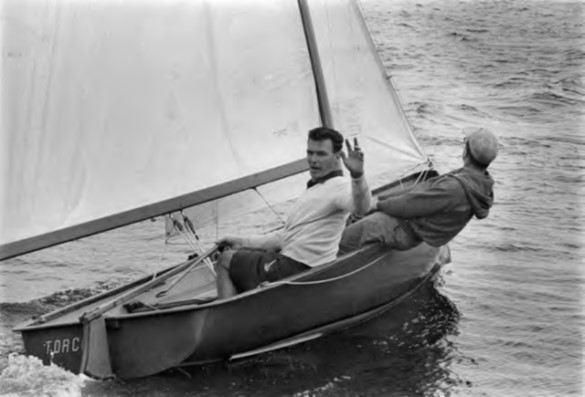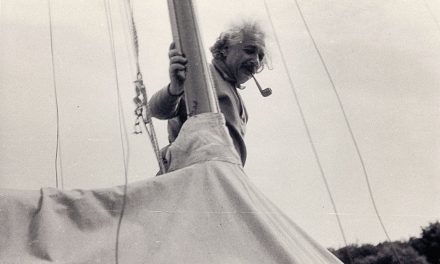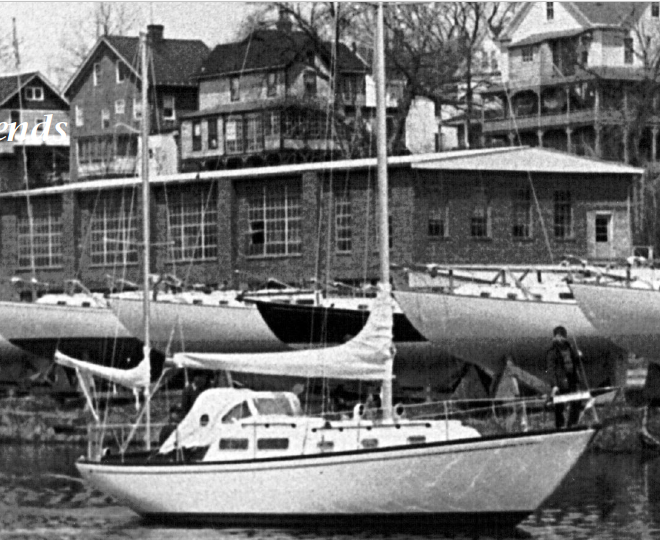Issue 141: Nov/Dec 2021
The sailing world in late July lost a giant, and many sailors—myself included—lost a good friend, with the passing of Bruce Kirby at age 92. He is most well-known, of course, for his design of the ubiquitous Laser, now an Olympic Class with over 250,000 boats being built. But the influence that this yachting journalist and racing sailor turned designer had on the sport he loved goes far deeper than one famous boat. Even without the Laser, he would have to be recognized as one of the most prolific and versatile designers during the “New Age of Sail” spanning the 1960s to the 1980s, and in Bruce’s case, right into his 80s.
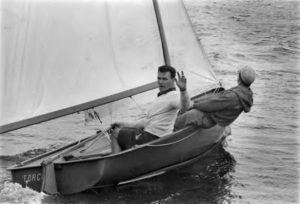
Bruce Kirby sails Torch, his first International 14 design, which became known as the Kirby I. Credit: Bruce Kirby.
Trained as a journalist, he worked for the Montreal Star before relocating to Chicago to become the editor of One-Design Yachtsman, which soon became One-Design and Offshore Yachtsman, then Yacht Racing, then Sailing World magazine. A racer in the highly competitive International 14 class, his first design—a 14 he named Torch that became known as the Kirby I—was born of frustration when he and other members of Canada’s team competing for the 1958 International 14 world team racing trophy in England were vexed by the New Zealanders’ upwind speed. With no engineering or design experience, he laid the design out on grid paper and literally counted the squares to determine sectional areas. Unusual for the time, he had her built of fiberglass.
His design approach was then and would continue to be highly intuitive. By his own admission, he was “never any good at math.” But in the case of the Kirby I, as with almost all of his designs, his intuition was bang on; the boat went upwind like a rocket ship. However, when she got to the weather mark, most of the fleet would plane by her. He learned from that and produced the Kirby II, again in fiberglass, a much stronger all-around performer.
But it was in a Kirby III called T’ief Up that his friend, Ian Bruce, won the prestigious Prince of Wales trophy—the ultimate symbol of International 14 sailing and design supremacy—back to back in 1967 and ’68 that established Kirby as the dominant designer in the 14 fleet.
Two years later, Bruce and Ian would team up again to design and build the Laser, and at the same time the Kirby V International 14. Though the latter was probably the most successful production 14 built, it was the Laser that attracted international attention, especially when it debuted at the 1971 New York Boat Show, where it immediately sold 144 boats.
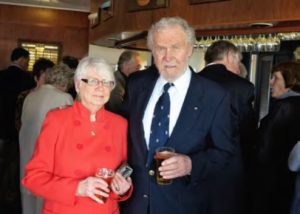
Margo and Bruce Kirby at the Kingston Yacht Club for his induction into the Canadian Sailing Hall of Fame. Credit: Rob Mazza.
Meanwhile, Clark Boat Company in Seattle, which was already building the Kirby IV, decided to branch into small keelboats with the growing popularity of the quarter-ton class under the newly introduced IOR. They asked Bruce to come up with a design. At this point in his career, he had never designed a keelboat, or any boat to a design formula. He had only rudimentary knowledge of stability and righting moment and an aged copy of the original Skeene’s Elements of Yacht Design to guide him. So, he turned to his friend, George Cuthbertson—with whom he had sailed a C&C Corvette to a class victory at the 1968 Southern Ocean Racing Conference (SORC)—for advice and guidance in these specialized topics.
The result was the San Juan 24, a boat that initiated the IOR shape of wide beam and pinched ends, predating both Doug Peterson’s Ganbare and Ron Holland’s Eygthene (which Bruce was always proud to note). Over 1,200 were built, and the boat would hold the record for the class that generated the greatest number of IOR certificates. The Clark brothers would initially balk at introducing a larger sister to the 24, but after the success of Kirby’s custom half-tonner Accolade—the first monohull built by the Gougeon brothers—the Clarks introduced the San Juan 30 in fiberglass production in 1974.
Though these designs were innovators in their own right, it was the success of the Laser that changed Kirby’s life. The royalties enabled Bruce and his wife, Margo, to buy a waterfront home in Rowayton, Connecticut, and for Bruce to start designing full time. From his drawing board emerged a number of successful one-design classes, among the most notable the Sonar (designed originally for his own Noroton Yacht Club), the Ideal 18 built by Ontario Yachts, and the Kirby 25 and 30 built by Mirage Yachts. He also designed a number of custom boats; the most successful was the 40-foot Runaway, which was part of the 1981 Canadian Admiral’s Cup team and Boat of the Year on Long Island Sound. He even designed a line of Norwalk Sharpies to be home-built in plywood, as well as a successful human-powered boat to cross the Atlantic.
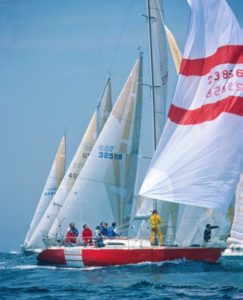
The custom 40-footer Runaway, designed by Kirby, was a member of the 1981 Canadian Admiral’s Cup team. Photo courtesy Bruce Kirby.
In the 1980s, the America’s Cup came calling through a commission from Canadian Marvin McDill that resulted in the 12 Metres Canada I for the 1983 challenge, which, when modified, became Canada II for the 1987 challenge. One modification was adding a winged keel, an innovation borrowed from Ben Lexcen’s Australia II in the 1983 campaign, and which Bruce used on his 8 Metre design Octavia to win the 8 Metre Worlds. When asked about his background in winged keels, in typical Bruce Kirby manner he replied, “I just took a wild-eyed swing at it!”
Bruce always worked alone in an office in his house, avoiding the temptation to hire staff. Like most old school, self-taught designers, he was reluctant to embrace the computer, and so he relied on Paul Fuchs, a University of Michigan naval architecture graduate who lived nearby, to translate his hand-drawn lines plans to computer models.
I first met Bruce sailing International 14s in my youth, and we maintained sporadic contact over the years. I wrote an in-depth look at his design career for Professional Boatbuilder, and I was chairman of the Canadian Hall of Fame and MC at the ceremony for his induction. Later, my wife and I would drop in to see Bruce and Margo in Rowayton, where we were always greeted warmly. A conversation with Bruce was always enjoyable and absent of rancor, even during his recent tribulations dealing with successive builders of the Laser that resulted in frustrating and costly legal entanglement.
Bruce was fortunate to be recognized for his achievements many times during his life. Along with his lifelong friend George Cuthbertson, he was an honorary co-curator of the New Age of Sail exhibit at the Marine Museum of the Great Lakes at Kingston, and both were the first inductees into the Canadian Sailing Hall of Fame. He was one of North America’s most talented helmsmen, representing his native Canada in three Olympics. He has also been inducted into the U.S. National Sailing Hall of Fame and the Canadian 14 Foot Dinghy Hall of Fame. Recently he was made a member of the Order of Canada, the highest distinction bestowed upon a Canadian citizen.
There were a number of intersections throughout Bruce’s life that led him to greater success, including George Cuthbertson, Roger Hewson, Dennis Clark, Ian Bruce, and even Mark Ellis (when Ellis was designing the Nonsuch, he turned to Kirby for advice on designing hulls with cat rigs). But beneath it all, his extraordinary self confidence and ability to ignore fear of failure allowed him not only to grasp opportunities as they came but to create those opportunities. He was an amazingly confident, yet self-effacing, individual with a prodigious memory; he could describe every leg of the 1958 team racing in England that led to his determination to beat the Kiwis upwind. He continued to sail competitively in the Sonar class at Noroton Yacht Club into his 80s. Looking back on a design career that spanned over 50 years, he admitted in his typically understated fashion that he was “lucky to hit things when they were happening!”
Bruce Kirby was simply a remarkable individual, and it was my privilege to know him.
Good Old Boat Technical Editor Rob Mazza is a mechanical engineer and naval architect. He began his career in the 1960s as a yacht designer with C&C Yachts and Mark Ellis Design in Canada, and later Hunter Marine in the U.S. He also worked in sales and marketing of structural cores and bonding compounds with ATC Chemicals in Ontario, and Baltek in New Jersey.
Thank you to Sailrite Enterprises, Inc., for providing free access to back issues of Good Old Boat through intellectual property rights. Sailrite.com

